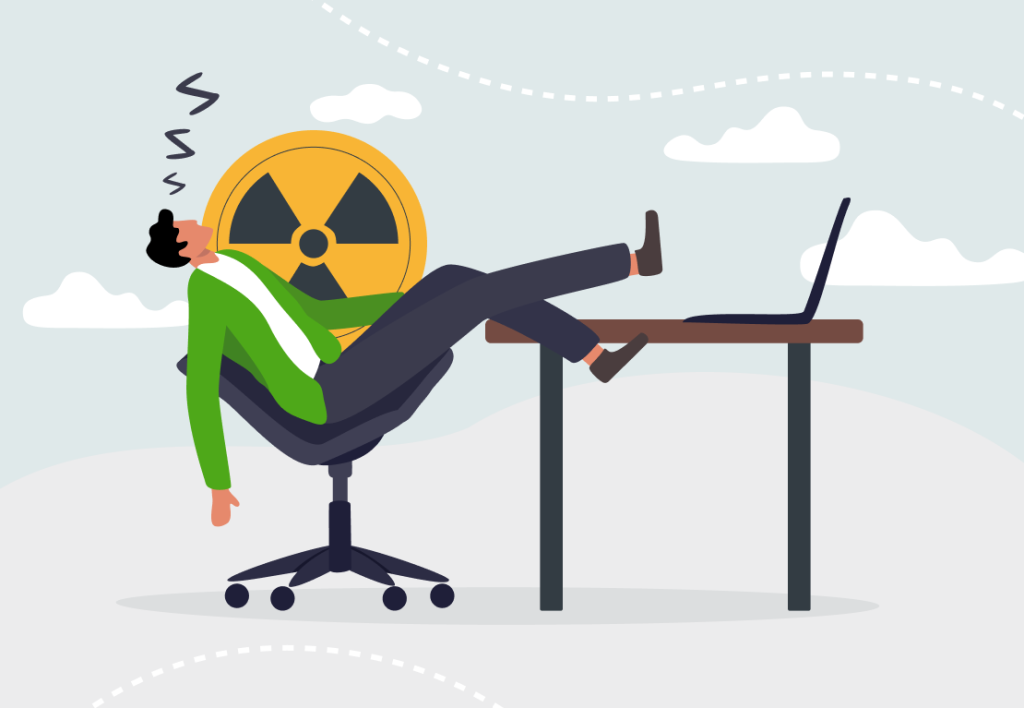How to manage toxic employees in the workplace

In the workplace, trust and positive relationships among colleagues are important. So, when someone acts toxic, it can harm the atmosphere for everyone else, like a bad apple spoiling the bunch. It’s a situation most of us have encountered at some point in our careers – and it’s never pleasant. It creates a negative atmosphere that hampers mood, productivity, and overall workplace dynamics.
If you’re a manager or a team leader, it’s important to know how to manage toxic employees. In this blog post, we’ll explore signs that might indicate someone on your team is being toxic, understand the reasons behind their actions, and provide you with strategies to deal with it.
Want to get the most out of your time?
Try DeskTime for free!
Try free for 14 days · No credit card required.
By signing up, you agree to our terms and privacy policy.

Recognizing toxic employees
A toxic employee is someone who makes work harder for everyone else with their behavior, which often involves things like:
- Negative attitude: One of the telltale signs of a toxic employee is their persistent negative attitude. They often complain, criticize, and rarely have anything positive to say about work-related matters.
- Gossip: Toxic employees in the workplace often gossip and spread rumors about coworkers, causing drama and mistrust within the team.
- Avoiding responsibility: Toxic individuals tend to avoid taking responsibility for their actions and mistakes. Instead, they shift blame onto others or make excuses, making it challenging to resolve problems and keep up the team spirit.
- Undermining colleagues: Toxic employees may undermine their colleagues’ efforts to make themselves look better in comparison. They’ll often downplay others’ achievements and attempt to take credit for their work.
- Bullying: Workplace bullies engage in toxic and aggressive behavior like name-calling, belittling, or even physical intimidation. Obviously, this creates a hostile and unpleasant work environment.
The list is not exhaustive – if you can think of any other examples of negative behavior in the workplace that undermine teamwork and mutual respect, it’s likely fair to categorize them as “toxic.” It can cause stress and make the workplace frustrating for those affected – and even for bystanders.
How to manage toxic employees
Let’s take a closer look at toxic employees and how to deal with them. You should start by documenting their behavior, then find out why they’re acting this way, and work on finding an appropriate solution.
Document their behavior
Gather evidence of the toxic behavior. Save emails or formal complaints from colleagues that highlight the problem. It’s important to collect clear evidence of a toxic employee’s behavior and how it affects colleagues, morale, and performance.
You need to be sure you’re dealing with a consistent pattern of toxic behavior rather than isolated incidents like a one-time outburst or a momentary bad mood. Keeping records is important if you have to report the issue to higher-ups or take further action.

Understand the cause
There are several reasons why an employee might act toxic at work. Understanding the root cause can be key to finding the right solution. To dig deeper, having a one-on-one conversation with the employee might be necessary.
There are different types of toxic employees – here are some common reasons why someone might act that way:
Job frustration: When employees feel undervalued or overworked, they may act out negatively to cope.
Example: An employee might be putting in extra hours they feel are unnecessary and vent their frustration on colleagues.
Personal issues: Outside problems like money or relationships can spill into work, causing toxic behavior.
Example: An employee going through a breakup might become irritable with coworkers.
Lack of skills: If someone doesn’t have the skills or training they need, they might act out of frustration.
Example: They might criticize others when they struggle with their own tasks.
Jealousy: Feeling threatened by a coworker’s success can lead to toxic behavior, like gossip or undermining.
Example: An employee might spread rumors about a colleague who got a promotion they wanted.
Management problems: Bad leadership or unfair treatment from bosses can trigger negativity.
Example: Criticizing management decisions when they seem unfair or biased.
Company culture: Work culture and policies can also influence toxic behavior, especially in environments that tolerate or encourage it.
Example: In a cutthroat workplace, employees may use toxic tactics to compete.

Look for a solution
Once you understand why a toxic employee behaves this way, it’s time to find the right solution. The last thing you want is for their negative behavior to continue unchecked.
Depending on how serious it is and why they’re acting this way, there are different ways to manage toxic employees in the workplace:
Communication and support: Start by having an open and empathetic conversation with the employee. Understand their perspective and express your concerns. Sometimes, just talking it out can lead to a positive change.
If personal issues are at the root of their behavior, offer support. This could involve connecting them with resources like counseling or employee assistance programs to help them cope with their challenges.
Professional development: If someone is acting toxic because they’re unhappy with their job and/or they lack certain skills, it’s a good idea to help them grow professionally.
For example, if they’re finding it hard to manage their workload and work/life balance, it could be a productivity management problem.
If they’re missing out on promotions due to skills gaps, training can bridge that gap and help them advance in their career – and feel better about themselves.
Reassignment: If the toxicity persists, explore the possibility of reassigning the employee to a different role or team. Sometimes, toxic behavior can stem from clashes between personalities that just don’t mesh well together.
This might involve relocating them to a team that aligns better with their personality or assigning them a role with fewer opportunities for engaging in toxic behavior.
Cultural changes: If multiple employees consistently behave toxically, it might indicate a bigger cultural problem in your company.
Is your workplace known for valuing respect, teamwork, empathy, and open communication? If not, it could be helpful to teach and encourage these values. Changing culture takes time – but a positive company culture that doesn’t tolerate toxic behavior can discourage potential wrongdoers.
Termination: In extreme situations where other measures fail, and the toxic behavior severely disrupts the workplace, you may need to terminate the employee. After all, you can’t let a toxic employee continue to make things difficult for others in the long run.

Want your employees to be happy?
Encourage your team to maintain a healthy work-life balance.
Don’t tolerate toxicity in your workplace
Dealing with workplace toxicity is nobody’s idea of fun. Negative attitudes can really mess with teamwork, productivity, and the general atmosphere at work. But it’s certainly not a hopeless situation – once you know how to manage toxic employees and understand why they’re acting out, you can handle the issue.
Sometimes, a good chat and support can do the trick. Other times, you might have to take more drastic actions, like letting someone go to protect the workplace.
Just remember – someone showing a bit of negativity or a bad mood every now and then doesn’t make them a toxic person. Don’t jump to conclusions – the occasional morning grumpiness before coffee doesn’t mean someone is toxic. Workplace stress can get the best of us at times, so it’s not fair to expect unwavering positivity 24/7.
Did you find this article useful? Give it a clap!
Psst! You can clap more than once if you really loved it 🙂